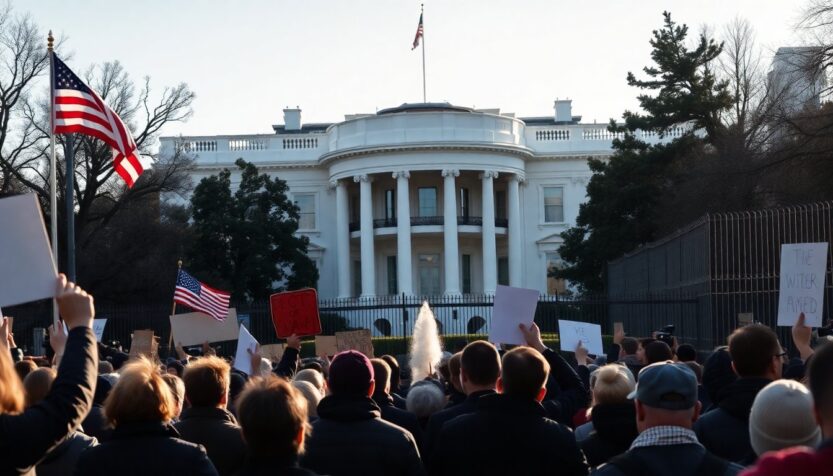The official website of the White House has become a battleground of political narratives as the government shutdown continues, with updates that seem to serve more as a tool for blame than as a historical account. Visitors to WhiteHouse.gov are greeted by a striking banner proclaiming, “Democrats Have Shut Down the Government,” accompanied by a live countdown clock ticking away the seconds since the shutdown began. This ongoing crisis has left approximately 1.4 million federal employees in limbo, with half considered essential workers enduring unpaid labor while the other half face furloughs.
This shutdown is not merely a lapse in government operations; it has also been weaponized by the Trump administration to redirect criticism towards the Democrats. For instance, updates to the website, including a recently altered history of the White House grounds, highlight Donald Trump’s plans for a significant renovation of the East Wing, which includes the construction of a lavish ballroom. This act of updating the history on the site raises questions about the priorities of an administration in crisis.
Historical revisions and political trolling
The newly revised timeline on the White House website starts with seemingly innocuous historical points, such as George Washington selecting the site for the White House in 1791 and the rebuilding of the structure after it was burned in 1814. However, the entries take a controversial turn when they reach more recent events. The timeline includes the scandal involving President Bill Clinton and intern Monica Lewinsky, framed as a significant event in the White House’s history. The narrative emphasizes the consequences that followed, including impeachment proceedings for perjury.
Controversial entries and omissions
Following the Clinton scandal, the timeline continues to detail various events, including an entry about President Barack Obama hosting members of the Muslim Brotherhood, which some have labeled as a terrorist organization. However, in a peculiar twist, the timeline promotes Melania Trump’s South Lawn tennis pavilion as a major accomplishment from 2025, overshadowing the global impact of the COVID-19 pandemic. This selective history raises eyebrows and begs the question of what constitutes a “major event” in the administration’s eyes.
Furthermore, the updates include a sensationalized image of Hunter Biden, with implications that the son of the former president may be linked to a cocaine discovery near the White House. Missing from this revised history are notable events such as Trump’s own impeachment or Richard Nixon’s resignation due to the Watergate scandal, which could arguably warrant a place in any comprehensive narrative of the building’s history.
The implications of the shutdown
The current government shutdown, which has already become one of the longest in U.S. history, is unprecedented in how it has been utilized by President Trump. Historically, shutdowns were a means to enforce federal law and ensure proper government funding, originating from the legal interpretations of Attorney General Benjamin Civiletti during President Jimmy Carter’s administration. The intent was to restore public trust in government operations.
However, the dynamics have shifted dramatically. Trump has leveraged the shutdown as a political strategy, framing it as an opportunity to take aim at the Democrats and push for his own agenda. This has included attempts to reduce federal employee numbers and reallocate federal funds to align with his priorities, a move that has drawn criticism for its potential to undermine the traditional balance of power.
Democrat responses and public sentiment
As Democrats firmly hold their ground against Trump’s tactics, the political stalemate continues. They argue that the president’s actions will ultimately backfire as public sentiment grows against the prolonged shutdown. With numerous federal workers going without paychecks and essential services at risk, the pressure mounts on both parties to find a resolution. Individuals like Senator Tim Kaine have voiced concerns over the extensive repercussions that the shutdown has on their constituents, suggesting that the ramifications could lead to a shift in public opinion.
The ongoing political struggle underscores a broader debate about the nature and purpose of government shutdowns in contemporary politics, challenging the notion of what the executive branch should prioritize during times of crisis. The evolving nature of the White House’s digital presence reflects this battle, as the site morphs into a platform for ideological warfare rather than a repository of historical facts.






